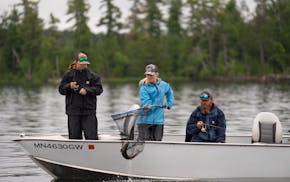GRAND RAPIDS, Minn. – Cass County Deputy Sheriff Bob Landreville and veteran fishing guide Dan Craven refer to their beloved Leech Lake as the mother of all Minnesota muskie lakes.
At a fishing forum last week at Timberlake Lodge, their voices stood out amid a crowd of industry stakeholders from across the state who aired a litany of concerns over the growing use of forward-facing sonar. The technology provides live, underwater video feeds that have greatly accelerated catch rates of muskies, crappies and large walleyes to the point of worry.
"The fish can't hide anymore," said Aaron Meyer, co-chair of the Minnesota Muskie and Pike Alliance. "They're as easy to see as the Star of Bethlehem."
About 180 people attended the event hosted by the MN-FISH Sportfishing Foundation. Among them were anglers, guides, state fisheries biologists, resort operators, fishing club members and bait shop owners.
"It's the hottest topic in fishing. … It has me very concerned," said Jeremy Smith, a lifelong angler who led the discussion of fishing's most accurate surveillance tool. "We've entered an era of more intelligent pressure."
Most vivid in Friday's discussion were tales of dead muskies floating on Leech Lake and other muskie waters. Landreville, Craven and Meyer of the Minnesota Muskie and Pike Alliance all talked about the unsettling new experience of seeing "floaters."
Minnesota muskie anglers are known for returning their catches to the water, but an alarming number of the fish are succumbing to the stress of being overhandled in boats or from barotrauma, a condition caused by rapid pressure changes when fish are brought to the surface from deep water.
In Leech and other lakes, the giant fish have become particularly vulnerable from June 1 until July 4, when big females retreat to deep caverns to recuperate from spawning, Craven and Landreville said. Those trophy-sized fish used to be nearly undiscoverable in their deep haunts, but anglers with forward-facing sonar gear now "sharp-shoot" or "road-hunt" them by roaming the surface, eyes on their video screens.
The technology is refined to the degree that anglers can identify which fish are worth casting, allowing them to drop baits directly in front of targets.
Craven recalled a day last summer when he guided walleye clients within sight of 25 muskie boats atop "Paris Trench," a well-known deep-water refuge in Leech Lake for post-spawn muskies.
"We can see the boats pile in there, and they're sharp-shooting," Craven said. "I found four or five floaters downwind from them."
Chad Engels, a cabin owner on Ottertail Lake, said teams of ice fishing guides equipped with the new technology worked together this winter to pinpoint schools of crappies on Ottertail. Then they led groups of up to 10 clients onto the ice for a bang-bang harvest, he said.
"It was 100 crappies day after day by the same guides working together," Engels said. "The lake can only take it for so long."
On Lake of the Woods, walleye tournament anglers have deployed forward-facing sonar to target the biggest possible specimens, said Joe Henry, a professional angler and tourism official. In four separate tournaments last year on the big lake, the winners averaged five-fish bags weighing around 50 pounds, he said.
During the forum, attendees suggested a variety of possible regulations or educational campaigns to ease the pressure on fish populations wrought by forward-facing sonar.
Landreville, who patrols Leech Lake as part of his job, said the mortality issue has become so obvious that a local coalition has launched a "Protect Leech Lake Muskies" campaign. Signs will soon be posted at all public access locations around the lake.
"Do NOT target muskies in water depths greater than 20 feet," the signs will say. The signs also will advise anglers to "limit muskie handling (and mortality) during the post spawn period, when fish are concentrated and vulnerable to angling methods that include Forward Facing Sonar."
Partners in the campaign include Leech Lake Tourism, two groups of fishing guides, the Brainerd chapter of Muskies Inc. and Reeds Family Outdoor Outfitters in Walker, Minn.
Craven said the coalition also will ask people to report dead muskie sightings to the Minnesota Department of Natural Resources (DNR) Tipline: 800-652-9093.
"Let's do something," Craven said to the audience. "We don't want to see this resource go away."
A couple of attendees cautioned against the use of new regulations to control technology such as forward-facing sonar. The video-centric equipment attracts young people to the sport at a time when fishing needs an infusion of new license buyers to fund conservation efforts, said Jimmy Bell, a member of the Minnesota Fishing Hall of Fame.
"We need to keep young anglers engaged. It keeps kids fishing," Bell said. "If you ban forward-facing, where do you stop?"
The forum, livestreamed by Devoted Outdoors, attracted more than 10,000 unique views. In no particular order, what follows are regulatory suggestions voiced by forum attendees:
- Limit fishing boats to a single forward-facing sonar unit.
- Ban the equipment from fishing tournaments.
- Require users to complete certified training on how to use the technology responsibly.
- Cut fish bag limits in half for anglers who deploy forward-facing sonar.
- Ban the equipment from certain "sonar-free" lakes.
- Ban the use of forward-facing sonar from night fishing.
- Disallow forward-facing sonar on muskie lakes between June 1 and July 4.

Xcel lets loose a small army of hungry sheep to keep its solar farm in order

Anderson: In early June, Minnesota fish are begging to be caught. Won't you help?

So you want to get an e-bike? Here's what you should know in Minnesota
Baby opossums are emerging from their mothers' pouches

